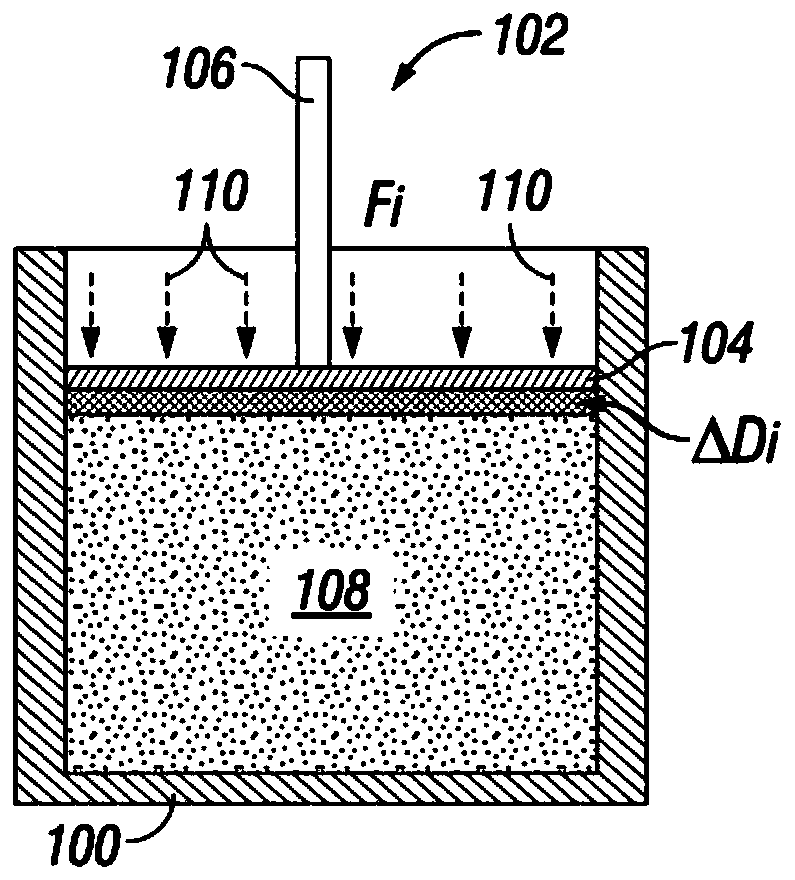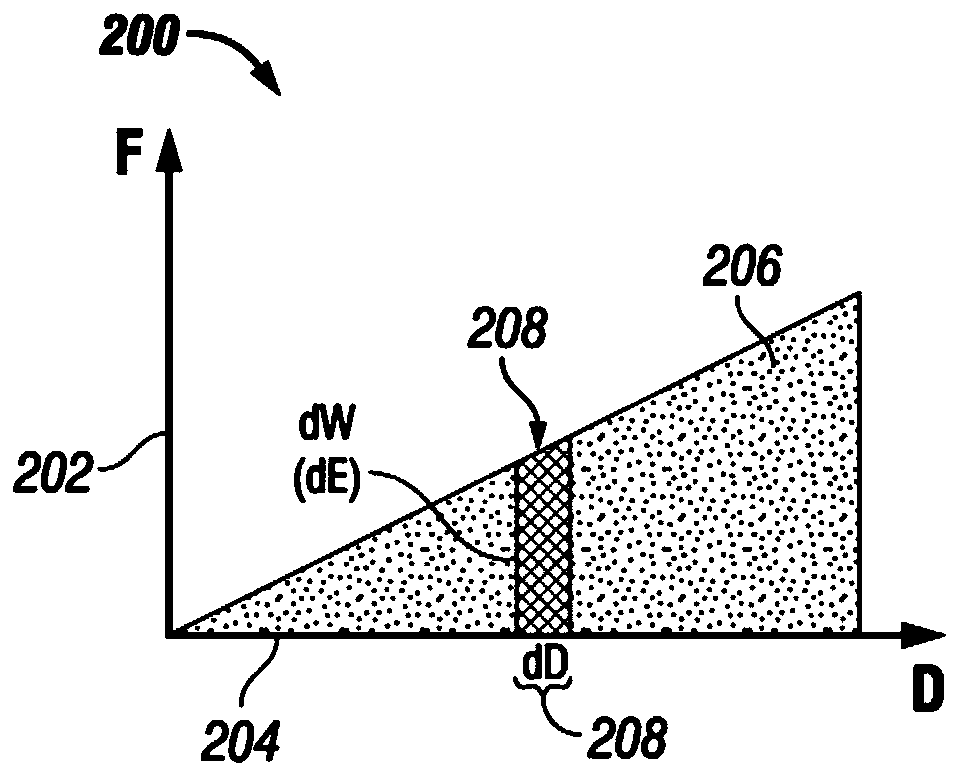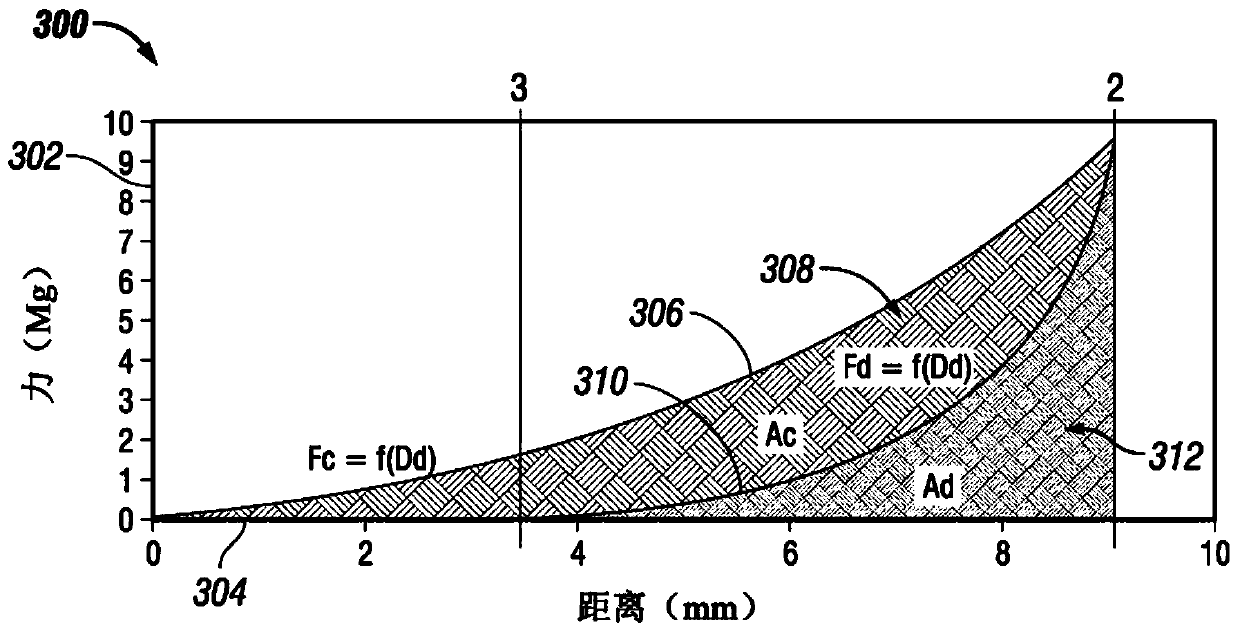Strain energy-based method and apparatus to determine the coefficient of resilience of lost circulation materials
A technology of rebound coefficient and plugging materials, applied in the direction of testing material strength, analyzing materials, measuring devices, etc. by applying stable tension/pressure
- Summary
- Abstract
- Description
- Claims
- Application Information
AI Technical Summary
Problems solved by technology
Method used
Image
Examples
example 1
[0069] Example 1 (Sample A)
[0070] Sample A was tested at a strain percentage of 20%. Figure 9 A plot 900 of force versus displacement is depicted for the resiliency test of Sample A, showing the determination of the coefficient of restitution of the sample. Such as Figure 9 As shown, the y-axis 902 depicts force and the x-axis 904 depicts the distance moved by the probe. Line 906 in graph 900 corresponds to the force-displacement curve generated during the compression cycle of the test of sample A, and line 908 corresponds to the force-displacement curve generated during the compression cycle of the test of sample A. Shaded area 910 below line 906 represents the absorbed strain energy during the compression cycles of the test. The absorbed strain energy was calculated to be 29.11 kgf-mm. Shaded area 912 below line 908 represents the strain energy released during the decompression cycle of the test. The released strain energy was calculated to be 11.58 kgf-mm.
[007...
example 2
[0072] Example 2 (Sample B)
[0073] Sample B was tested at a strain percentage of 30%. Figure 10 Depicted is a graph 1000 of force versus displacement for the resiliency test of Sample B, showing the determination of the coefficient of restitution of the sample. Such as Figure 10 As shown, the y-axis 1002 depicts force and the x-axis 1004 depicts the distance moved by the probe. Line 1006 in graph 1000 corresponds to the force-displacement curve generated during the compression cycle of the test of Sample B, and line 1008 corresponds to the force-displacement curve generated during the compression cycle of the test of Sample B. As discussed above with respect to Sample A, shaded area 1010 below line 1006 represents strain energy absorbed during the compression cycle of the test, and shaded area 1012 below line 1008 represents strain energy released during the decompression cycle of the test. The absorbed strain energy corresponding to the shaded region 1010 was calculate...
example 3
[0075] Example 3 (Sample C)
[0076] Sample C was tested at a strain percentage of 40%. Figure 11 Depicted is a graph 1100 of force versus displacement for the resiliency test of Sample C, showing the determination of the coefficient of restitution of the sample. Such as Figure 11 As shown, the y-axis 1102 depicts force and the x-axis 1104 depicts the distance moved by the probe. Line 1106 in graph 1100 corresponds to the force-displacement curve generated during the compression cycle of the test of sample C, and line 1108 corresponds to the force-displacement curve generated during the compression cycle of the test of sample C. As discussed above with respect to Samples A and B, the shaded region 1110 below line 1106 represents the strain energy absorbed during the compression cycle of the test, and the shaded region 1112 below line 1108 represents the strain released during the decompression cycle of the test energy. The absorbed strain energy corresponding to shaded r...
PUM
| Property | Measurement | Unit |
|---|---|---|
| diameter | aaaaa | aaaaa |
| height | aaaaa | aaaaa |
| diameter | aaaaa | aaaaa |
Abstract
Description
Claims
Application Information
 Login to View More
Login to View More - R&D
- Intellectual Property
- Life Sciences
- Materials
- Tech Scout
- Unparalleled Data Quality
- Higher Quality Content
- 60% Fewer Hallucinations
Browse by: Latest US Patents, China's latest patents, Technical Efficacy Thesaurus, Application Domain, Technology Topic, Popular Technical Reports.
© 2025 PatSnap. All rights reserved.Legal|Privacy policy|Modern Slavery Act Transparency Statement|Sitemap|About US| Contact US: help@patsnap.com



